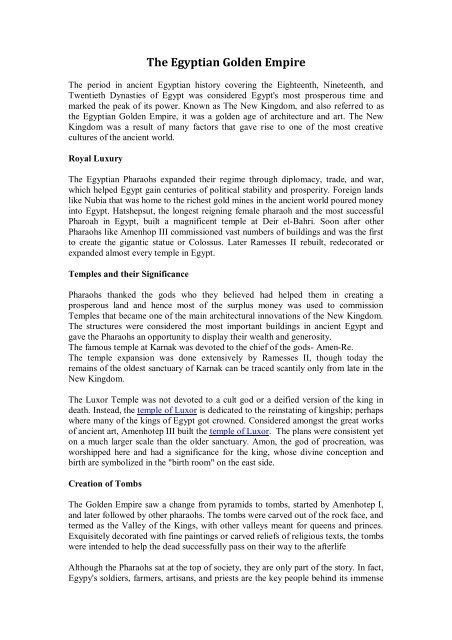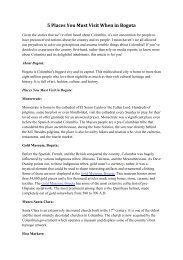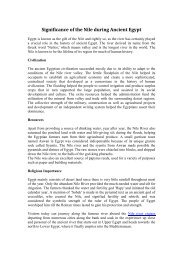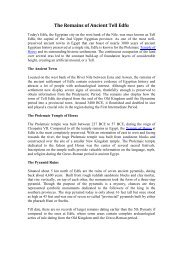The Egyptian Golden Empire
The period in ancient Egyptian history covering the Eighteenth, Nineteenth, and Twentieth Dynasties of Egypt was considered Egypt's most prosperous time and marked the peak of its power. For more details visit http://themaritimeexplorer.ca/2017/07/30/luxor/
The period in ancient Egyptian history covering the Eighteenth, Nineteenth, and Twentieth Dynasties of Egypt was considered Egypt's most prosperous time and marked the peak of its power. For more details visit http://themaritimeexplorer.ca/2017/07/30/luxor/
- No tags were found...
Create successful ePaper yourself
Turn your PDF publications into a flip-book with our unique Google optimized e-Paper software.
<strong>The</strong> <strong>Egyptian</strong> <strong>Golden</strong> <strong>Empire</strong><br />
<strong>The</strong> period in ancient <strong>Egyptian</strong> history covering the Eighteenth, Nineteenth, and<br />
Twentieth Dynasties of Egypt was considered Egypt's most prosperous time and<br />
marked the peak of its power. Known as <strong>The</strong> New Kingdom, and also referred to as<br />
the <strong>Egyptian</strong> <strong>Golden</strong> <strong>Empire</strong>, it was a golden age of architecture and art. <strong>The</strong> New<br />
Kingdom was a result of many factors that gave rise to one of the most creative<br />
cultures of the ancient world.<br />
Royal Luxury<br />
<strong>The</strong> <strong>Egyptian</strong> Pharaohs expanded their regime through diplomacy, trade, and war,<br />
which helped Egypt gain centuries of political stability and prosperity. Foreign lands<br />
like Nubia that was home to the richest gold mines in the ancient world poured money<br />
into Egypt. Hatshepsut, the longest reigning female pharaoh and the most successful<br />
Pharoah in Egypt, built a magnificent temple at Deir el-Bahri. Soon after other<br />
Pharaohs like Amenhop III commissioned vast numbers of buildings and was the first<br />
to create the gigantic statue or Colossus. Later Ramesses II rebuilt, redecorated or<br />
expanded almost every temple in Egypt.<br />
Temples and their Significance<br />
Pharaohs thanked the gods who they believed had helped them in creating a<br />
prosperous land and hence most of the surplus money was used to commission<br />
Temples that became one of the main architectural innovations of the New Kingdom.<br />
<strong>The</strong> structures were considered the most important buildings in ancient Egypt and<br />
gave the Pharaohs an opportunity to display their wealth and generosity.<br />
<strong>The</strong> famous temple at Karnak was devoted to the chief of the gods- Amen-Re.<br />
<strong>The</strong> temple expansion was done extensively by Ramesses II, though today the<br />
remains of the oldest sanctuary of Karnak can be traced scantily only from late in the<br />
New Kingdom.<br />
<strong>The</strong> Luxor Temple was not devoted to a cult god or a deified version of the king in<br />
death. Instead, the temple of Luxor is dedicated to the reinstating of kingship; perhaps<br />
where many of the kings of Egypt got crowned. Considered amongst the great works<br />
of ancient art, Amenhotep III built the temple of Luxor. <strong>The</strong> plans were consistent yet<br />
on a much larger scale than the older sanctuary. Amon, the god of procreation, was<br />
worshipped here and had a significance for the king, whose divine conception and<br />
birth are symbolized in the "birth room" on the east side.<br />
Creation of Tombs<br />
<strong>The</strong> <strong>Golden</strong> <strong>Empire</strong> saw a change from pyramids to tombs, started by Amenhotep I,<br />
and later followed by other pharaohs. <strong>The</strong> tombs were carved out of the rock face, and<br />
termed as the Valley of the Kings, with other valleys meant for queens and princes.<br />
Exquisitely decorated with fine paintings or carved reliefs of religious texts, the tombs<br />
were intended to help the dead successfully pass on their way to the afterlife<br />
Although the Pharaohs sat at the top of society, they are only part of the story. In fact,<br />
Egypy's soldiers, farmers, artisans, and priests are the key people behind its immense
success and legacy.<br />
Author Bio: A specialist in ancient <strong>Egyptian</strong> art and archaeology, the author has<br />
particular interests in the architecture of the New Kingdom era. <strong>The</strong> Temple of Luxor<br />
is his personal favorite.
















